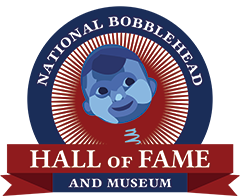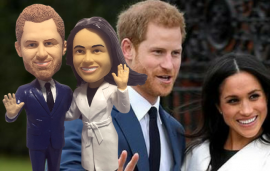From The Hartford Courant –
For 15 years, Tim Hunter reveled in his life as a niche collector.
From his home in Reno, Nev., Hunter was the foremost authority on all things Bobblehead. He collected and sold the kitschy dolls that were so popular among kids in the 1960s. He wrote a collector’s guide that helped place values on the dolls and was the only known full- time collector.
Aside from being notable among memorabilia collectors, Hunter lived a relatively quiet life.
All that has changed. These days, Hunter fields calls from Bobblehead neophytes and reporters who seek his advice and opinions.
“It’s like the rest of the world discovered them,” Hunter said. “Honestly? It’s sort of strange.”
Strange?
How about thousands of fans waiting in the rain outside the Metrodome in Minneapolis, vying to be the first fans through the gate so they could fetch their Bobblehead replica of Harmon Killebrew?
Or how about the people bidding on eBay for an Andy Pettitte Bobblehead doll, a day after the toy was given to fans at Yankee Stadium?
Or consider the adults who have haggled with stadium ticket- takers at several parks when denied aBobblehead doll because of an 18-and-under stipulation?
Or the fact that Omar Vizquel, Kenny Lofton and Jim Thome Bobblehead dolls were sold by the Indians months before the merchandise arrived?
“It’s kind of a goofy sort of thing,” Hunter said. “I suppose they’re a uniquely American thing … part of pop culture. But no, I don’t understand this.”
Hunter is not alone. Sports marketing types who make their living by tracking the next big trend were caught off guard by the Bobblehead explosion this summer.
And unlike huge fads of the past — namely, Beanie Babies — this wave could last for a while.
“This has legs,” said Patrick Klinger, the vice president of marketing for the Twins. “I’ve never seen anything like this.”
Klinger and the Twins were on the cusp of the Bobblehead hype, after giving fans Killebrew, Tony Oliva and Kent Hrbek dolls last season. The reaction was so overwhelming — 27,000 showed up when 5,000 Killebrew dolls were handed out — that other teams took notice.
“Literally, tens of thousands of people were lining up outside of the Metrodome, hours before the game, in a rainstorm,” Klinger said. “The passion the people have for these dolls is amazing.”
Credit for the revival lies with the San Francisco Giants. In 1999, the Giants were searching for a way to honor Willie Mays — something retro, but something unique.
The team’s marketing people called Alexander Global promotions, a Bellevue, Wash., sports promotion company, and asked about producing a Bobblehead doll in the likeness of Mays.
This was a perfect promotion. Bobbleheads would appeal to baby boomers, who saw Mays as a player, and kids who just like funky collectibles. When fans lined up early for the doll, it was obvious this toy could be the next big marketing item.
“They called us that day and placed an order for Barry Bonds dolls for the next season,” said Malcolm Alexander, president of Alexander Global Promotions.
A Nod To History
The history of the Bobbleheads dates to the 1920s, but the dolls didn’t become popular until the ’50s. Celebrity Bobblehead dolls made a small impact on the memorabilia market before the dolls hit the sports world.
In 1961, the first sports Bobbleheads appeared at stadiums and in souvenir shops. The papier mache-and-plastic dolls were generic, with the same cherubic faces wearing uniforms of various teams.
By the late 1970s, the popularity faded.
“It’s always been a niche market,” Hunter said. “Even now, it’s a small part of the sports collectable industry. And the people I deal with are still more interested in the old stuff. I don’t see the old collectors demanding, say, an Ichiro doll.”
The Ichiro doll, in the likeness of Seattle All-Star rookie Ichiro Suzuki, may be the most popularBobblehead produced this summer. Distributed Saturday at Safeco Field in Seattle, it was a huge item before it was unveiled. Tickets to Saturday’s game were being sold on eBay last week and the doll was being offered for $150 two days before it was available.
Why the hype?
Alexander said the toy appeals to people at all levels.
“Collectors obviously love it,” Alexander said. “But it also fits on the bookcase in a kid’s room. It fits on the desk in a CEO’s office. It transcends those ranges. A plastic coffee mug or a baseball doesn’t do that. The other thing is timing. There was a void in the market and the time was right for something big.”
Alexander’s company works with about 20 major league baseball teams. They also have produced dolls for teams in other sports — NBA, NHL and NFL teams are jumping on the Bobblehead bandwagon– along with NASCAR promoters.
The other player in the Bobblehead world is Bensussen Deutsch & Associates, another Washington state company that works with about 15 teams and has been producing the dolls for more than 20 years.
Both companies manufacture the heavy, ceramic dolls with the same method: After studying many stills of a player’s face, the dolls are produced and sent to the team for approval. Players have the opportunity to study the dolls and seek alterations, and some players have made special requests — tattoos, earrings and scars have been added to increase the authenticity.
When Alexander sent a model of the Derek Jeter doll to the Yankees, the team had a request.
“We got the pictures, we keyed in on one in particular and we produced a doll that looked exactly like the picture,” Alexander said. “It had a five o’clock shadow. Well, the Yankees called us and said they have a no-facial-hair policy, so how could the doll have whiskers? So we had to change it.”
Alexander said some requests are bizarre. The Twins requested Dave Winfield and Kirby Puckett dolls, which were the same height. The beef from the 6-foot-6 Winfield: How can his doll be the same height as the Puckett doll, since Kirby is 5-8?
A change was made.
“It’s all about perceptions,” Alexander said. “Say you’re doing Willie Mays. Is it Willie in his rookie year? Willie in the middle, or Willie in the final years? What does Willie remember? What doesWillie‘s wife remember Willie looking like? … So you can have a good number of changes based on perceptions.”
Agents sometimes will ask that a player’s doll be more muscular or svelte, which runs counter to what Alexander’s company strives for. His dolls, he said, are rather round on purpose — focus groups have indicated fans prefer the chubby bodies under the head of their favorite athlete because it makes the dolls more accessible.
When the Ichiro doll was sent to Japan a few years ago, Alexander received an e-mail from team management.
“It said, `It is Ichiro, but it is not,'” Alexander said. “What they meant to say was, it looks exactly like his face, but what’s going on below? It took about a week to explain the humor and what we were trying to get across.”
Bensussen Deutsch & Associates have been more willing to produce dolls with more realistic physiques. And as the craze heightens, both companies will vie for orders from teams.
“Reality counts,” said Jay Deutsch, CEO and president of Bensussen Deutsch & Associates. “We make players come to life.”
And with a seemingly endless supply of players, the Bobbleheads will be churned out over the next few years. While Beanie Baby and Pokemon items have faded into the collectable graveyard, these dolls could be around for a while.
Banned In Boston?
Other sports are following the trend. The Minnesota Timberwolves had Bobblehead giveaways last season and the residue is seen on eBay – – bids were being taken for, believe it or not, a Chauncey Billups Bobblehead.
Billups was drawing a bid of $9.99.
Other possibilities include broadcasters (the Brewers distributed Bob Uecker dolls), stars of less glamorous sports (jockey Chris McCarron’s doll was being sold on eBay last week) and managers. The Rock Cats gave away a two-faced Bobblehead replica of twins Stan and Stu Cliburn, the team’s manager and pitching coach. One face was Stan, the other Stu.
“With the source of players and building on 40 years of history, this will be around for a while,” Hunter said.
And when teams add marquee players, what better way to excite fans than to issue a Bobbleheadtribute? Collectors can have the Jason Giambi 2001 Bobblehead this year and add the 2002 Giambi in another uniform next summer.
“The possibilities,” Alexander said, “really are endless.”
There also are markets that will enter the world of Bobbleheads late. While places like San Francisco and Minneapolis have been exposed to the dolls, Boston has not been part of the hype. The Red Sox, never on the cutting edge of marketing, are the only team to not have a Bobblehead giveaway since the dolls hit the market in 1999.
A Pedro Martinez or Manny Ramirez doll? If players such as Garret Anderson and Tony Womack can be immortalized in Bobblehead land, the Red Sox stars should get their due.
“Honestly, I get so many calls from people who want information about these,” Klinger said. “Corporations, minor league teams … you name it. Everybody wants to be a part of this. This will only get bigger.”
Photos: (2 color), Associated Press; Caption: THE BRAIN BEHIND THE BOBBLEHEAD CRAZE belongs to Malcolm Alexander, whose latest creation, the Ichiro Suzuki doll, was a smash hit Saturday in Seattle. THE BOBBLEHEAD BUSINESS isn’t child’s play as this young fan found out on Saturday in Seattle, watching lines form to get the Ichiro doll.

